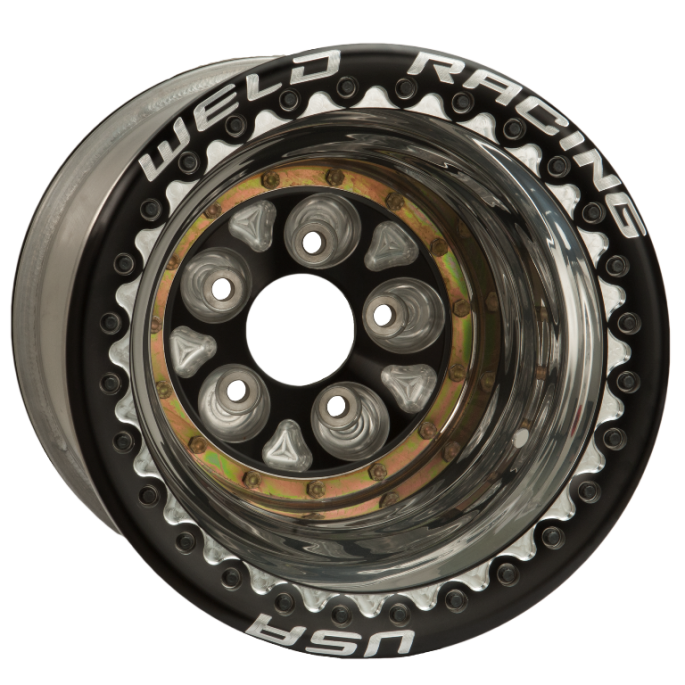Of all the parts that take incredible abuse on a Top Fuel Dragster or Nitro Funny Car, the drive wheels are right there at the top of the list. In the blink of an eye they go from being at rest to having the full fury of the 8,000hp motor forced upon them and then seconds later they are taxed with the centrifugal forces of spinning at more than 320mph on a great run. Now go ahead and do this dozens upon dozens of times without failing.
The guys at Weld Racing know about the construction of these wheels almost better than anyone because they worked hand in hand with several organizations to create the design and construction techniques that are now the 15.4 SFI wheel spec that is mandatory on all competition Top Fuel Dragsters and Funny Cars. The words “bomb proof” do not really do justice to how built these units really are. We’d literally hide under one if there was an impending nuclear attack.
Our pal Greg Smith at Weld wrote a neat piece on just how these wheels came to be. Scroll down to read it. You’ll be blown away like we were at the forces involved and to what lengths Weld and their partners went to make sure they had created the next generation in performance and safety when it comes to the most tortured racing wheels on the planet!
Here’s the story of how SFI 15.4 wheels came to be!
In 2002 Weld Racing developed a new drive wheel for “nitro” class drag racing cars. It was in response to annual leaps in power and speed in this racing class. A new SFI specification sprang from the new wheel and became mandatory in NHRA competition. While the new Weld version wheel had an upgraded center and Bead-Loc design, the SFI 15.3 spec raised the deflection study bending moment test load from 6,000 lb-ft to 12,000 lb-ft. In addition the dynamic cornering fatigue test is a 1,700 lb-ft bending moment for 30,000 cycles and the dynamic radial fatigue test is a radial load of 2,000 pound for 400,000 cycles. As a result, the Weld Racing Magnum P.R.O. became the first SFI 15.3 wheel in production.
In 2009, due to the increased speeds and lower elapsed times of nitro fueled racing cars, collaboration between Scott Rider of Weld Racing, John Medlin of John Force Racing, Ford Motor Company and Goodyear, named the Medlin Project, created a new drive wheel for nitro class cars. In 2010 the John Force Racing team tested and raced on this new version wheel. During this time, under the consultation of Scott Rider and John Medlin, the SFI 15.4 specification was written. For 2011 any racer with a nitro car could purchase these new, stronger, and safer SFI 15.4 wheels from Weld Racing as they were the first in production. For the 2012 racing season all nitro cars are required by the NHRA to race on SFI 15.4 wheels.
SFI 15.4 wheels differ from 15.3 wheels in many ways as the SFI 15.4 specification is a material and design specification.
The bolt-on beadlock ring must be made of 7075-T6 aluminum with minimum yield strength of 65,000 psi and minimum tensile strength of 75,000 psi. Both the beadlock receiver rings and the bolt-on rings must have a maximum O.D. of 17.25”. The bolt-on rings must be retained with 24 to 28 fasteners with a minimum diameter of 5/16”. The minimum material under the beadlock ring bolt heads must be 0.300” thick. There can be no lightening pockets in the ring mating surfaces of the beadlock rings. No lightening pockets may extend beyond the beadlock fastener bolt circle. The weld filler material for all construction welds (beadlock receiver and rim shells) must be 5356 or 4043 alloy.
The SFI 15.4 spec requires modular wheels to have a center bolt load distribution ring manufactured from 4130 (chrome-molybdenum) steel 0.125” thick sandwiching the rim shell flanges between the ring and the wheel center. Weld Racing, though not required to do so, adds 15 close tolerance NAS (aerospace 160,000 psi) bolts 3/8” in diameter through-bolted and retained by high temperature self locking JET nuts which are made of 160,000 psi corrosion resistant steel to connect the center to the rim shell.
An SFI 15.4 spec wheel cannot be altered in any way from its as-delivered configuration and components from different wheel manufacturers cannot be mixed. These actions will result in a decertification of the wheel for competition.
Not related to SFI spec 15.4 is the 2012 NHRA requirement for all nitro classes to add drive lugs to the axle flange and wheel mounting face that interlock. This prevents the wheel studs from being placed in shear in the unpredicted event that the clamping force from the studs is inadequate to prevent movement between the axle mounting flange and the wheel mounting flange. Placing the wheel studs in shear can potentially result in stud failure and wheel separation.
Today Weld Racing LLC continuously evolves its products to improve both performance and safety as both are vital attributes to any racing component. Innovation separates the leaders from the followers.


























On the topic of drag wheels… Can anybody explain to me how “liner” tires and wheels work. Like the ones some fast door-cars run? My assumption is they are different than just a standard tube type slick…..